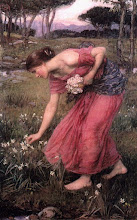
During the summer one of our days out in the Lake District was to Grasmere to visit the two houses lived in by the poet William Wordsworth. The little white house is Dove Cottage. William and his sister Dorothy moved here in 1799 and in 1802 William married Mary Hutchinson and their three eldest children were born here.

Clicking on the photograph will enlarge it so that you can read the information. Ullswater is 9 miles from Grasmere so we didn't see the actual place where Wordsworth saw his 'host of golden daffodils', that will have to be for a future visit.

This is the back of the cottage taken from the middle of the steep little garden which William and his sister designed and where they spent much of their time. The house you can see beyond wasn't there in the early 1800s so there would have been a lovely view across the fell at the time when the Wordsworths lived there.

There were always a lot of visitors staying with the Wordsworths at Dove Cottage and with their growing family it became too small. I have to say that it would have been quite a squash with just William,Mary and Dorothy! Apparently at times it was a bit like a modern sleepover with people sleeping on the floor wherever they could find space. It must have been absolute chaos! In 1808 they moved and, after brief periods in two other houses, in 1813 they moved to Rydal Mount which is in the photo above. They lived here for the next 46 years.

The summer house at Rydal Mount where William Wordsworth often sat composing his poetry.

A view from the garden looking down to Rydal Water.
 This is the parish church of St Oswald in Grasmere which dates back to the very early 14th century.
This is the parish church of St Oswald in Grasmere which dates back to the very early 14th century.  A plaque giving a little information about the church and the saint to whom it is dedicated.
A plaque giving a little information about the church and the saint to whom it is dedicated. This is the grave of William Wordsworth and his wife Mary.
This is the grave of William Wordsworth and his wife Mary.
This is the Wordsworth family plot in St Oswald's churchyard with the grave of Dorothy Wordsworth in the centre. Dorothy kept a detailed journal of her life at Dove Cottage which wasn't published until after her death. It's a fascinating book giving a vivid picture of life and the countryside in the early 19th century.
 The interior of the church showing the medieval Nave and the ancient timber roof trusses.
The interior of the church showing the medieval Nave and the ancient timber roof trusses. 
The arches in the previous picture were made in the 1500s when the original church was enlarged and they give access to the Langdale Aisle in the above photo. We happened to be in Grasmere in the week following the annual Rushbearing Ceremony. The medieval Nave was made of beaten earth until the 1800s when it was finally flagged. The floor of the church was covered in rushes to sweeten the air and try(vainly I imagine!)to keep dampness and mud at bay. The rushes were renewed annually with great ceremony, this describes it better than I can. In the photo you can see the rush covered floor.

This is the font also decorated for the Rushbearing, Wordsworth's children were baptized here.

Grasmere has another claim to fame besides William Wordsworth and that is Grasmere Gingerbread originally invented by Sarah Nelson. The package in the photograph was bought from the cottage where Grasmere Gingerbread was originally made.

The contents of the package - long since gone I'm afraid! It's an odd mix of a biscuit and a cake but very moorish.

A final view of the countryside around Grasmere, it's a really beautiful area and well worth visiting if you ever get chance.





































